- Choosing the Right Variety
- Fragrance
- Color
- Growth Habits
- Preparing the Soil for Planting
- 1. Choose a Suitable Location
- 2. Clear the Area
- 3. Prepare the Soil
- 4. Add Organic Matter
- 5. Test the Soil pH
- 6. Level and Rake the Soil
- Planting Hyacinth Bulbs
- Choosing the Right Location
- Preparing the Soil
- Planting the Bulbs
- Caring for Hyacinth Bulbs
- Conclusion
- Taking Care of Hyacinth Flowers
- Planting
- Watering
- Fertilizing
- Removing Faded Flowers
- Protecting from Extreme Temperatures
- Dividing and Transplanting
- Watering and Fertilizing Hyacinth Plants
- Watering Hyacinth Plants
- Fertilizing Hyacinth Plants
- Dealing with Pests and Diseases
- Pests
- Diseases
- Harvesting and Using Hyacinth Flowers
- 1. Harvesting
- 2. Arranging Hyacinth Flowers
- 3. Hyacinth Potpourri
- 4. Hyacinth Flower Tea
- 5. Drying Hyacinth Flowers
- Tips for Growing Hyacinth Indoors
- 1. Choosing the Right Bulbs
- 2. Providing the Right Environment
- 3. Proper Watering
- 4. Fertilizing
- 5. Preventing Pest Infestations
- 6. Supporting Growth
- 7. Deadheading and Pruning
- 8. After Blooming Care
- Q&A:
- How do I plant hyacinth bulbs?
- What is the best soil for growing hyacinth?
- How often should I water hyacinth plants?
- Do hyacinth flowers require any special care?
- Can I grow hyacinths indoors?
- Video: How to Begin Covert Gardening – Hyacinth Bean Plant
If you’re looking to add a burst of color and fragrance to your home or garden, hyacinths are a perfect choice. These beautiful flowers are known for their strong, sweet scent and vibrant blooms. Whether you’re a seasoned gardener or just starting out, learning how to plant, grow, and care for hyacinths will allow you to enjoy their beauty year after year.
Hyacinths are native to the Mediterranean region and are part of the Asparagaceae family. They come in a variety of colors, including shades of blue, purple, pink, and white. Their bell-shaped flowers grow on tall, sturdy stems, making them an ideal addition to any garden or floral arrangement.
One of the key factors in successfully growing hyacinths is choosing the right location for planting. These flowers prefer full sun or partial shade, so it’s important to find an area that receives at least 6-8 hours of sunlight each day. Additionally, hyacinths thrive in well-draining soil, so if your soil tends to retain water, consider adding compost or peat moss to improve drainage.
When it comes to planting hyacinths, timing is essential. For optimal growth, it’s best to plant hyacinth bulbs in the fall, ideally before the first frost. This allows the bulbs to establish roots before winter and ensures they bloom come springtime. To plant, dig a hole that’s two to three times as deep as the bulb itself and place the bulb in the hole with the pointed end facing upwards. Cover with soil and water thoroughly.
Caring for hyacinths is relatively straightforward. Regular watering is important, especially during dry spells or periods of prolonged heat. However, be mindful not to overwater, as excess moisture can cause the bulbs to rot. Fertilize hyacinths with a balanced, slow-release fertilizer in the spring and remove any dead or faded flowers to encourage further blooming.
Overall, hyacinths are a delightful addition to any home or garden. With their captivating fragrance and vibrant colors, planting, growing, and caring for these flowers is a rewarding experience. So, why not bring a touch of beauty and aroma into your life with hyacinths?
Choosing the Right Variety
When it comes to choosing hyacinth flowers for your home or garden, there are a few important factors to consider. The right variety of hyacinth can make a big difference in terms of fragrance, color, and growth habits.
Fragrance
One of the main reasons people choose to grow hyacinths is for their delightful fragrance. Different varieties of hyacinths have different levels of fragrance, so it’s important to choose a variety that offers the scent you desire. Some popular fragrant varieties include ‘Delft Blue’, ‘Jan Bos’, and ‘Fondant’.
Color
Hyacinths come in a wide range of colors, including shades of pink, purple, white, yellow, and blue. Consider the color scheme of your garden or home when choosing a variety. Some popular colorful varieties include ‘Woodstock’ (purple), ‘Pink Pearl’, and ‘City of Haarlem’ (yellow).
Growth Habits
Another important factor to consider when choosing a hyacinth variety is its growth habits. Some varieties are better suited for growing in containers, while others are more suitable for mass plantings in garden beds. Consider the height and spread of the plant, as well as its overall growth habit, when making your selection.
Here are a few popular hyacinth varieties and their recommended uses:
| Variety | Recommended Use |
|---|---|
| ‘Peter Stuyvesant’ | Container planting |
| ‘Blue Jacket’ | Garden bed planting |
| ‘Purple Sensation’ | Cut flowers |
By considering fragrance, color, and growth habits, you can choose the right variety of hyacinth to suit your preferences and the needs of your garden or home.
Preparing the Soil for Planting
Before planting hyacinths, it’s important to prepare the soil to provide the best growing conditions for these fragrant flowers. Here are some steps to follow:
1. Choose a Suitable Location
Select a sunny spot in your garden that receives at least 6 hours of direct sunlight per day. Hyacinths thrive in well-drained soil, so make sure the chosen location doesn’t have any pooling water or poor drainage.
2. Clear the Area
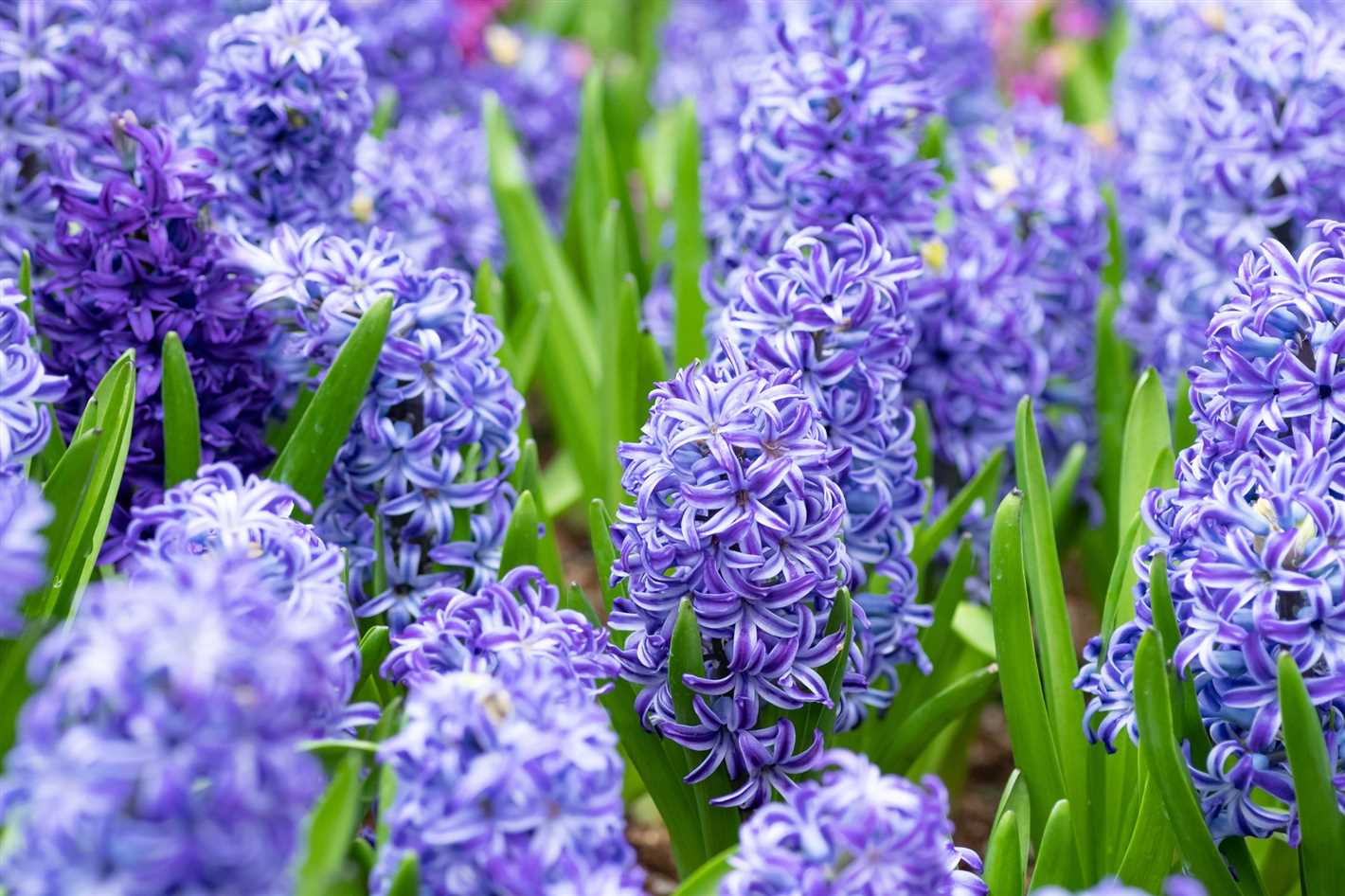
Remove any weeds, rocks, or other debris from the planting area. This will ensure that the hyacinth bulbs have plenty of space to grow and won’t have to compete with other plants for nutrients.
3. Prepare the Soil
Loosen the soil using a garden fork or tiller to a depth of about 8 to 10 inches. Break up any clumps of soil and remove any large rocks or roots that may interfere with bulb growth. This will also improve the soil’s drainage and allow the roots to penetrate easily.
4. Add Organic Matter
For optimal growth, incorporate organic matter into the soil. This can be done by adding compost, well-rotted manure, or peat moss. These organic materials will improve the soil structure, enhance moisture retention, and provide essential nutrients for the hyacinths.
5. Test the Soil pH
Test the soil pH using a soil testing kit to ensure it falls within the optimal range for hyacinths, which is between 6.0 and 7.0. If the pH is too acidic, add lime to raise it, or if it’s too alkaline, add sulfur to lower it. This step will help ensure that the hyacinths can absorb the necessary nutrients from the soil.
6. Level and Rake the Soil
Once the soil has been prepared and amended, use a rake to level the surface. This will provide a smooth and even planting bed for the hyacinth bulbs.
By following these steps to prepare the soil, you’ll create an ideal environment for planting hyacinths and ensure their healthy growth and fragrant blooms.
Planting Hyacinth Bulbs
Hyacinth bulbs are a popular choice for adding color and fragrance to your garden. These beautiful flowers come in a range of shades, including pink, purple, white, and blue. Planting hyacinth bulbs is a simple process that can be done in the fall for spring blooms or in the spring for summer blooms.
Choosing the Right Location
When selecting a location for your hyacinth bulbs, it’s important to choose a spot that receives full sun or partial shade. Hyacinths thrive in well-draining soil, so make sure the area has good drainage to prevent the bulbs from rotting. They also prefer soil that is slightly acidic to neutral.
Preparing the Soil
Before planting your hyacinth bulbs, prepare the soil by removing any weeds or debris. Loosen the soil to a depth of 12 inches and mix in some organic matter, such as compost or well-rotted manure, to improve drainage and fertility.
Planting the Bulbs
Hyacinth bulbs should be planted 4-6 inches deep and spaced 4-6 inches apart. Dig a hole for each bulb and place it in the hole with the pointed side facing up. Fill in the hole with soil and gently firm it around the bulb.
Caring for Hyacinth Bulbs
After planting, water the bulbs thoroughly to settle the soil around them. Keep the soil evenly moist but not waterlogged throughout the growing season. Once the hyacinth flowers start to bloom, you can provide additional support by using stakes or plant rings to prevent them from flopping over. After the flowers have faded, allow the foliage to die back naturally before removing it.
Conclusion
Planting hyacinth bulbs is an easy way to add beauty and fragrance to your garden. By selecting the right location, preparing the soil, and caring for the bulbs properly, you can enjoy these gorgeous flowers year after year.
Taking Care of Hyacinth Flowers
Hyacinth flowers are known for their vibrant colors and delightful fragrance. To ensure that your hyacinth flowers thrive and continue to bloom year after year, it’s important to provide them with proper care. Here are some tips for taking care of your hyacinth flowers:
Planting
- Choose a location that receives full sunlight or partial shade.
- Prepare the soil by adding organic matter, such as compost, to improve drainage.
- Plant the hyacinth bulbs in the fall, about 4 to 6 inches deep and 4 to 6 inches apart.
- Water the bulbs thoroughly after planting to settle the soil.
Watering
- Keep the soil evenly moist, but not waterlogged.
- Water the hyacinth flowers regularly, especially during dry spells.
- Avoid overhead watering, as it can lead to disease and rot.
Fertilizing
- Apply a balanced fertilizer to the soil in early spring, just as the hyacinth flowers start to emerge.
- Follow the instructions on the fertilizer package for the correct application rate.
- Avoid over-fertilizing, as this can cause the leaves to grow excessively and overshadow the flowers.
Removing Faded Flowers
- Pinch off or cut the faded flowers to prevent seed production.
- This encourages the hyacinth plants to put their energy into bulb formation for the next year.
Protecting from Extreme Temperatures
- Hyacinth flowers are hardy, but extreme cold or heat can damage them.
- In areas with harsh winters, cover the hyacinth bulbs with a layer of mulch to insulate them.
- In areas with hot summers, provide some shade during the hottest parts of the day.
Dividing and Transplanting
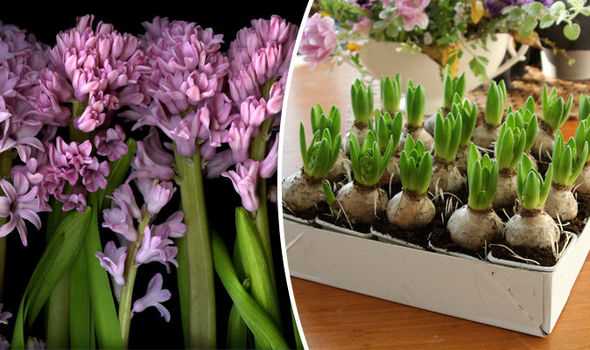
- After a few years, hyacinth bulbs may become crowded and produce fewer flowers.
- To rejuvenate the plants, dig up the bulbs in late summer or early fall.
- Separate the bulbs and replant them in fresh, well-prepared soil.
By following these care guidelines, you can enjoy the beauty and fragrance of hyacinth flowers in your garden for years to come.
Watering and Fertilizing Hyacinth Plants
Watering and fertilizing are essential components of caring for hyacinth plants. By providing the right amount of water and nutrients, you can ensure the healthy growth and vibrant blooms of your hyacinths. Here are some guidelines to help you properly water and fertilize your hyacinth plants:
Watering Hyacinth Plants
Hyacinths require regular and consistent watering, especially during their active growth period. Here are some tips for watering your hyacinth plants:
- Water your hyacinths deeply once a week, providing enough moisture to penetrate the soil to a depth of 6-8 inches.
- Avoid overwatering, as excessive moisture can lead to root rot. Make sure the top inch of soil is dry before watering again.
- Water the plants at the base, avoiding wetting the foliage and flowers. Wet leaves can promote fungal diseases.
- Consider using a drip irrigation system or a soaker hose to water hyacinths efficiently and prevent water waste through evaporation.
Fertilizing Hyacinth Plants
Fertilizing hyacinth plants helps provide the nutrients they need for healthy growth and blooming. Here are some guidelines for fertilizing your hyacinth plants:
- Apply a balanced, slow-release fertilizer with an NPK ratio of 10-10-10 or 15-15-15 in early spring, just as the hyacinths emerge from the ground.
- Follow the package instructions for the appropriate amount of fertilizer to use based on the size and number of your hyacinth plants.
- Avoid applying fertilizer directly on the leaves or flowers to prevent burning or damage.
- Water the plants thoroughly after fertilizing to help the nutrients penetrate the soil and reach the roots.
- Reapply fertilizer every 4-6 weeks throughout the growing season, following the same instructions for dosage.
- Stop fertilizing in late summer to allow the plants to enter their dormant phase.
Remember to always read and follow the instructions on the fertilizer package and adjust the dosage based on your specific hyacinth plants’ needs. By providing adequate watering and proper fertilization, you can enjoy beautiful and fragrant hyacinth blooms in your garden.
Dealing with Pests and Diseases
Hyacinths are generally quite resistant to pests and diseases but they can occasionally be affected. Here are a few common problems you may encounter and some solutions to deal with them.
Pests
- Aphids: These small insects can be a nuisance for your hyacinths. They can usually be controlled by spraying the plants with a strong jet of water or by using an insecticidal soap.
- Slugs and snails: These pests can cause damage to the leaves and flowers of your hyacinths. To protect your plants, you can use organic slug pellets or set up beer traps to attract and drown them.
- Nematodes: Nematodes are tiny worms that can attack the roots of your hyacinths. To prevent infestation, make sure to plant your hyacinths in well-drained soil and avoid overwatering. If nematodes are already present, you may need to treat the soil with a commercial nematode control product.
Diseases
- Botrytis blight: This fungal disease can cause gray mold to develop on the leaves and flowers of your hyacinths. To prevent its spread, remove any affected parts immediately and avoid overhead watering. You can also treat your plants with a fungicide if necessary.
- Leaf spot: Leaf spot is a bacterial disease that causes dark spots to appear on the leaves of your hyacinths. To prevent its spread, avoid overcrowding your plants and make sure they have good air circulation. Remove any affected leaves and consider treating the plants with a copper-based fungicide.
- Root rot: Root rot is a fungal disease that affects the roots of your hyacinths, usually due to overwatering or poorly drained soil. To prevent root rot, ensure that the soil is well-drained and avoid overwatering. If root rot has already occurred, you may need to remove and replace the affected bulbs.
By following these tips, you can keep your hyacinths healthy and thriving, free from pests and diseases. Remember to regularly inspect your plants and take action at the first signs of any issues to prevent them from spreading.
Harvesting and Using Hyacinth Flowers
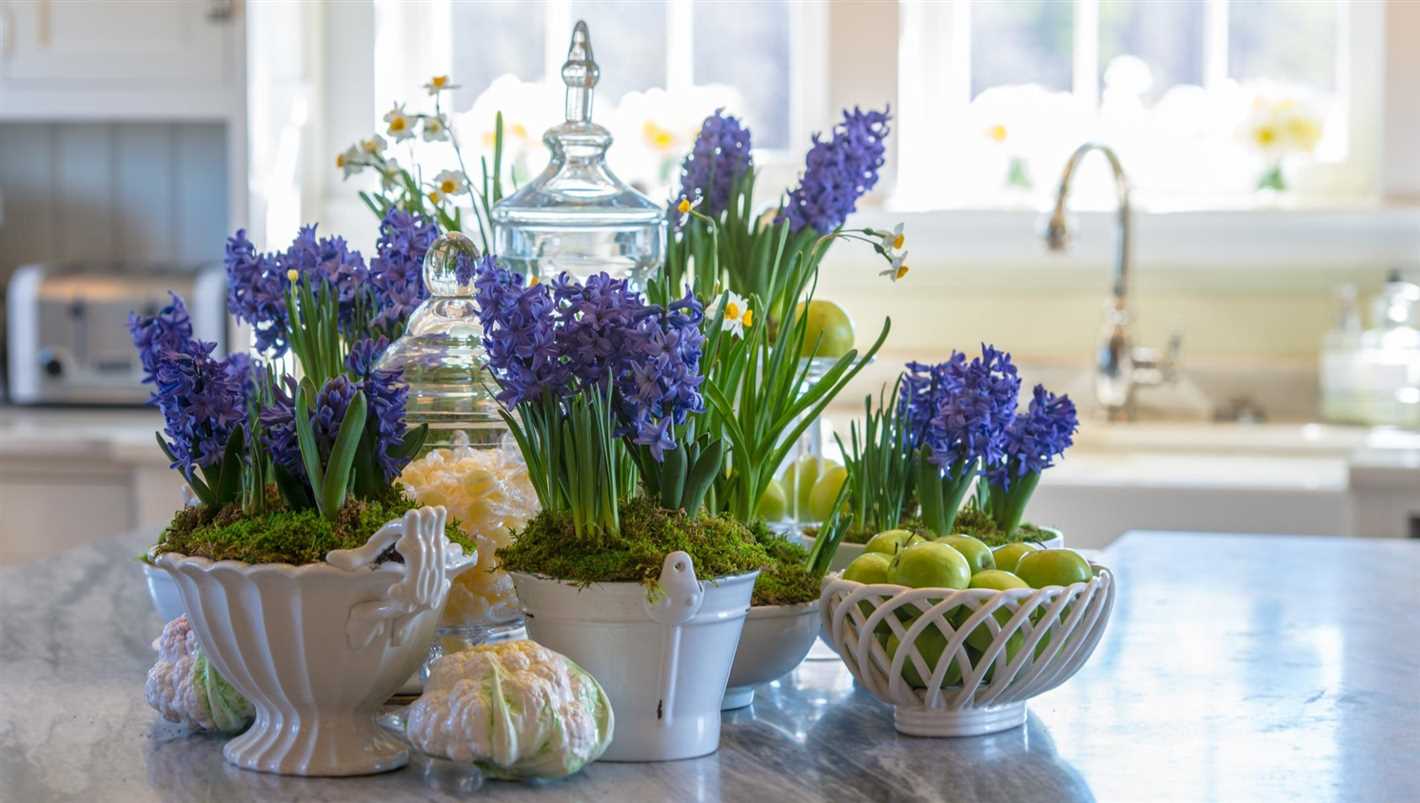
Once your hyacinth plants have reached full bloom, it’s time to start enjoying their fragrant flowers. Here are some tips on how to harvest and use hyacinth flowers:
1. Harvesting
To harvest hyacinth flowers, wait until the blooms have fully opened and the flowers are at their peak. Choose flowers that are vibrant in color and have a strong fragrance.
Use a clean pair of sharp garden shears or scissors to cut the stem of the hyacinth flower, making sure to leave a few inches of stem attached. This will help preserve the life of the flower once it is cut.
2. Arranging Hyacinth Flowers
Hyacinth flowers make lovely additions to floral arrangements. Their vibrant colors and sweet fragrance can brighten up any space.
Before arranging the hyacinth flowers, remove any leaves or foliage that will be below the water line. This will prevent the growth of bacteria and keep the water clean.
Place the hyacinth flowers in a vase filled with fresh water. Make sure to change the water every few days to keep the flowers fresh for longer.
3. Hyacinth Potpourri
Another great way to enjoy the fragrance of hyacinth flowers is by making potpourri. Gather the petals from the harvested flowers and allow them to dry completely.
Once the petals are dry, mix them with other dried flowers, herbs, and spices of your choice. Store the potpourri in a decorative jar or bag to preserve the fragrance.
4. Hyacinth Flower Tea
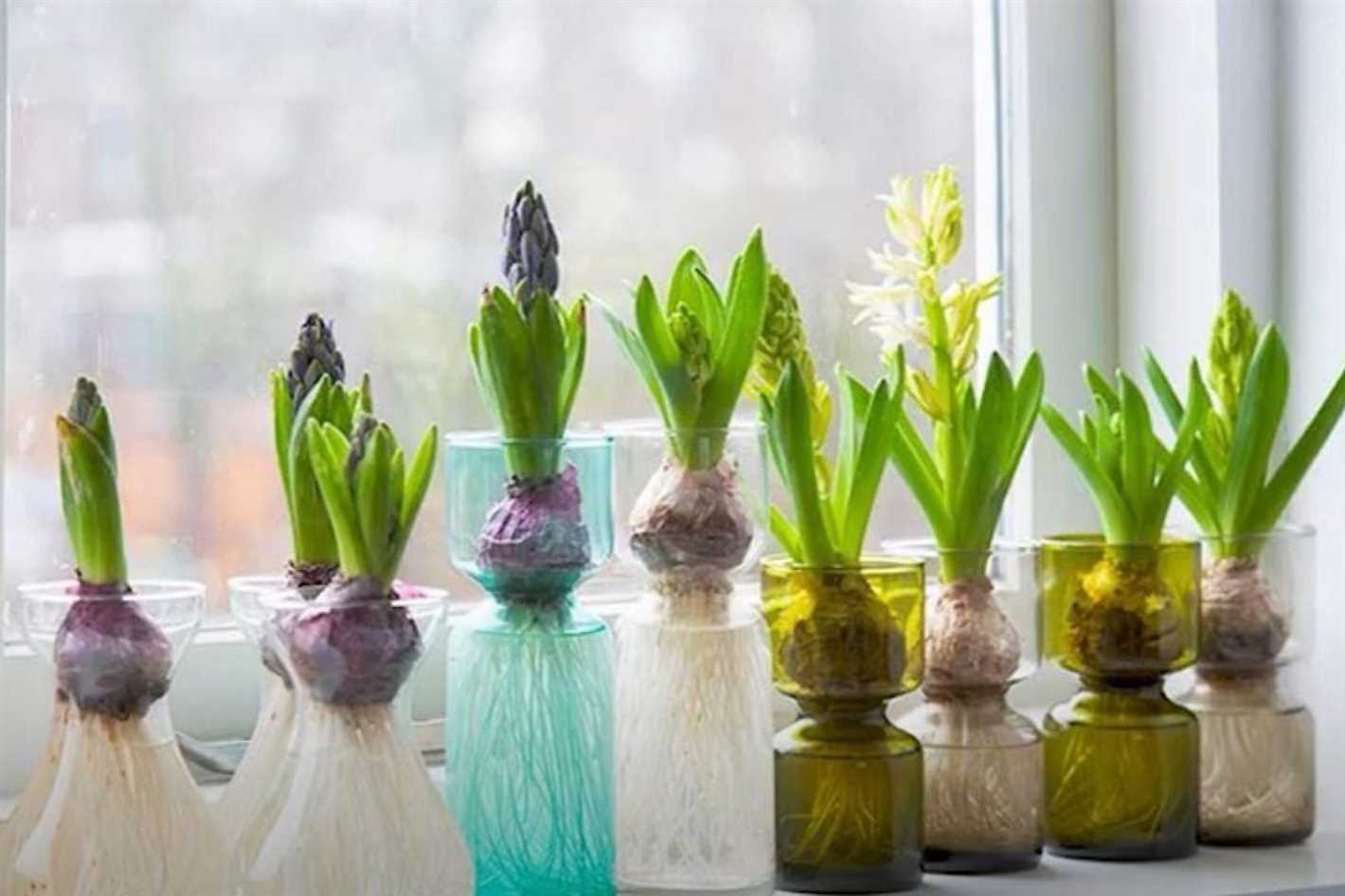
If you’re looking for a unique way to enjoy hyacinth flowers, consider making hyacinth flower tea. This fragrant tea is not only delicious but also offers potential health benefits.
To make hyacinth flower tea, steep the dried flowers in hot water for several minutes. You can add honey or other sweeteners to taste. Enjoy the floral aroma and delicate flavor of the tea.
5. Drying Hyacinth Flowers
If you want to preserve hyacinth flowers for a longer period, you can choose to dry them. Hang the harvested flowers upside down in a dark and well-ventilated area. After a few weeks, the flowers should be completely dry and ready for storage or crafting projects.
Once dried, you can use the flowers in various crafts, such as making potpourri sachets, wreaths, or pressed flower art.
Remember to handle hyacinth flowers with care, as they can cause mild skin irritation or allergic reactions in some individuals. If you’re unsure about the safety of a particular use, it’s best to consult with a knowledgeable expert.
Tips for Growing Hyacinth Indoors
Hyacinths are beautiful and fragrant flowers that can be grown indoors. Here are some tips for successfully growing hyacinth indoors:
1. Choosing the Right Bulbs
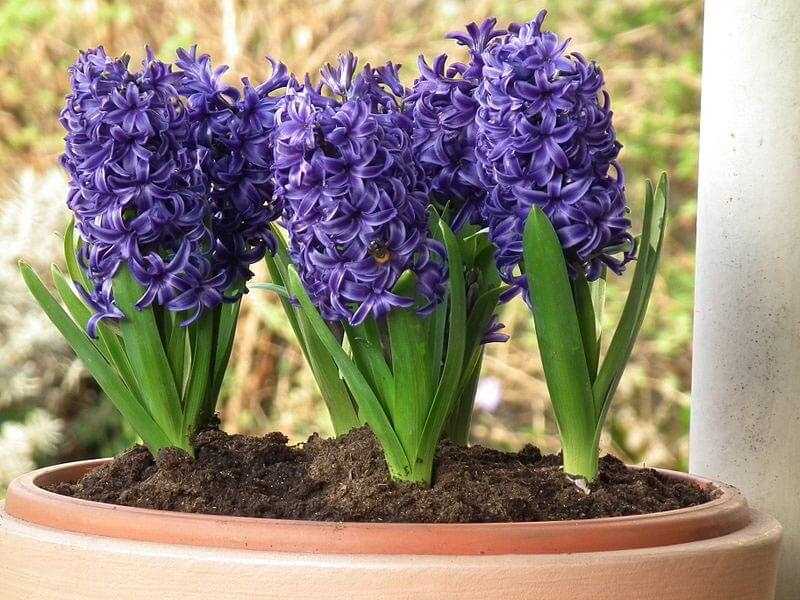
Start by selecting healthy bulbs from a reputable source. Look for bulbs that are firm and without any visible damage or signs of mold.
2. Providing the Right Environment
Hyacinths prefer cool temperatures and bright indirect light. Place them in a cool room where the temperature is around 60-65°F (15-18°C). Avoid placing them near heaters or radiators as this can cause them to dry out or wilt prematurely.
3. Proper Watering
Water the hyacinth sparingly to keep the soil slightly moist but not overly wet. Overwatering can lead to root rot. Allow the top inch of soil to dry out between waterings.
4. Fertilizing
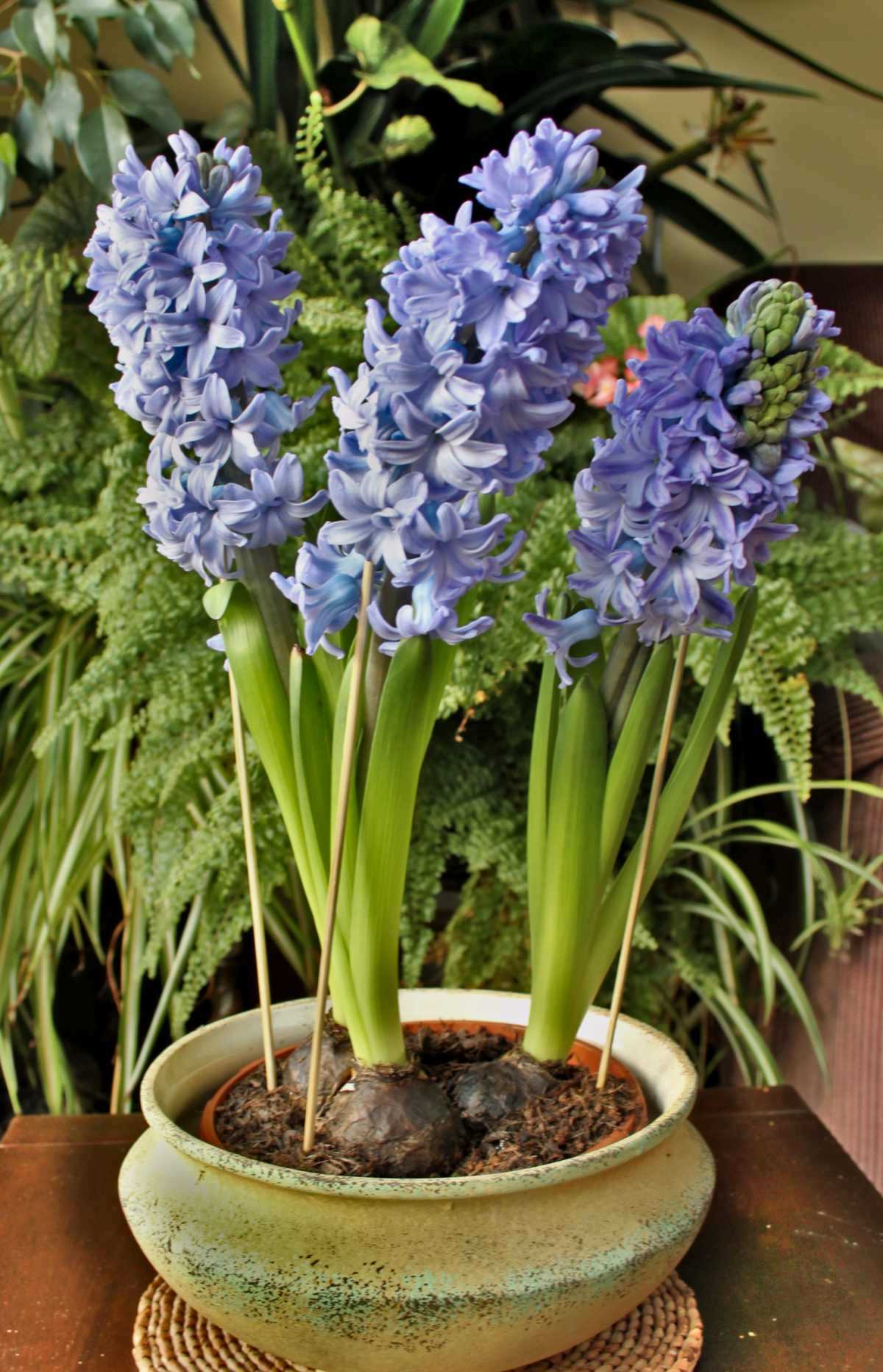
Fertilize the hyacinth once every two weeks with a balanced, water-soluble fertilizer. Dilute the fertilizer according to the manufacturer’s instructions and apply it to the soil around the bulb.
5. Preventing Pest Infestations
Keep an eye out for common pests such as aphids and spider mites. If you notice any infestations, treat them with insecticidal soap or neem oil according to the product instructions.
6. Supporting Growth
To keep the hyacinth stems upright as they grow, you can use stakes or small supports. This will help prevent them from bending or breaking under the weight of the blooms.
7. Deadheading and Pruning
Remove faded or wilted flowers by gently pinching them off at the base. This will help redirect the plant’s energy towards producing new blooms. Prune any yellow or withered leaves to maintain the plant’s appearance.
8. After Blooming Care
After the hyacinth has finished blooming, you can either discard the bulb or allow it to go dormant. If you choose to keep the bulb, stop watering and allow the foliage to die back naturally. Store the bulb in a cool, dry place until it’s time to replant it.
By following these tips, you can enjoy the beauty and fragrance of hyacinths indoors. Experiment with different varieties and colors to create a stunning display in your home.
Q&A:
How do I plant hyacinth bulbs?
To plant hyacinth bulbs, choose a location with well-draining soil and partial to full sunlight. Dig a hole about 6 inches deep and place the bulb in the hole with the pointed end facing up. Cover the bulb with soil and water thoroughly. It’s best to plant hyacinth bulbs in the fall for spring blooming.
What is the best soil for growing hyacinth?
The best soil for growing hyacinth is well-draining soil with a neutral pH. Hyacinths prefer loamy soil that is rich in organic matter. It’s important to avoid heavy clay soil, as it can cause the bulbs to rot. You can improve the soil by adding compost or peat moss before planting.
How often should I water hyacinth plants?
Hyacinth plants require regular watering, especially during the growing season. Water the plants deeply once a week, ensuring that the soil is evenly moist. Avoid overwatering, as it can cause the bulbs to rot. During hot and dry spells, you may need to water more frequently.
Do hyacinth flowers require any special care?
Hyacinth flowers require some special care to ensure healthy growth. It’s important to deadhead the flowers after they fade to prevent the plant from putting energy into seed production. After the leaves turn yellow, you can cut them back to the ground. You should also fertilize the plants once a year in the fall with a balanced fertilizer.
Can I grow hyacinths indoors?
Yes, you can grow hyacinths indoors. To do so, you’ll need to force the bulbs by providing them with a period of cold treatment. Place the bulbs in a paper bag and store them in the refrigerator for about 12 to 14 weeks. After the cold treatment, plant the bulbs in a pot with well-draining soil and place them in a cool location with indirect sunlight. Water the bulbs regularly and you should see them bloom in about 2 to 3 weeks.
Video:
How to Begin Covert Gardening – Hyacinth Bean Plant







